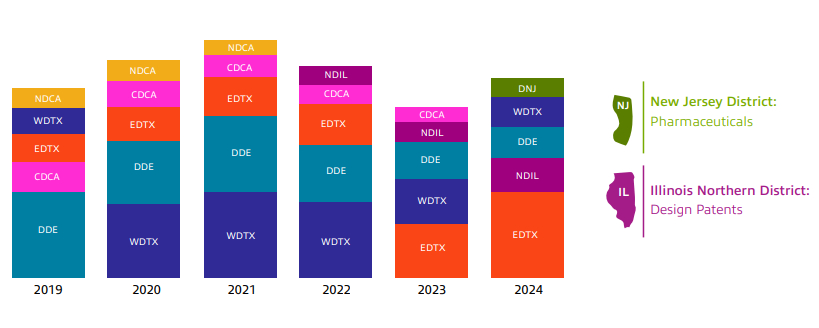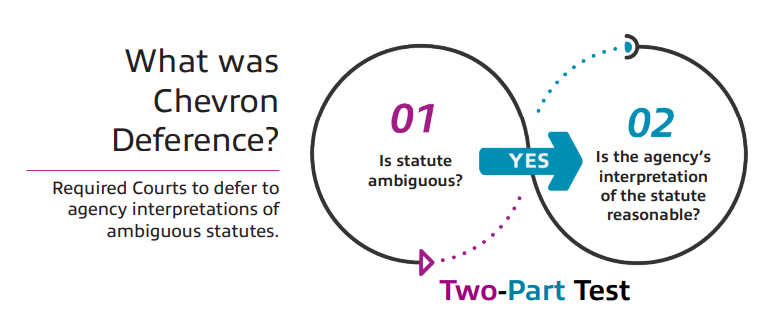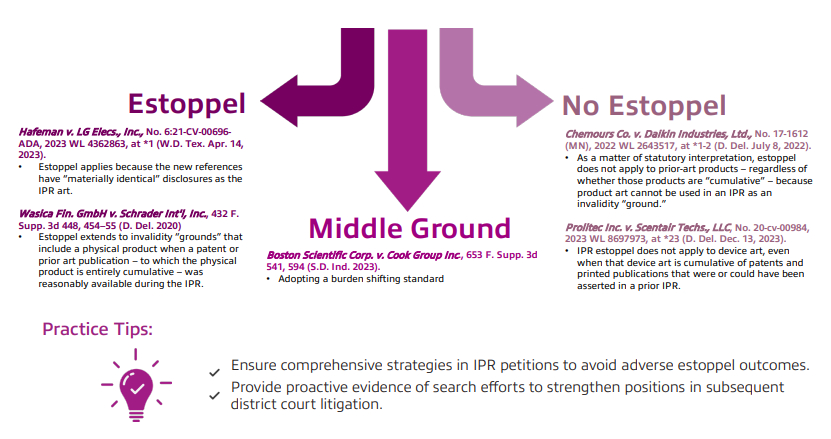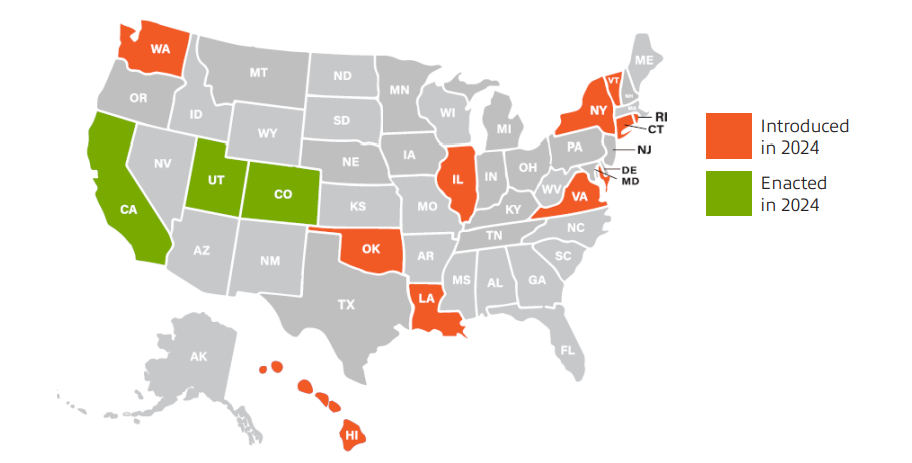- within Intellectual Property topic(s)
- with readers working within the Business & Consumer Services and Insurance industries
- within Intellectual Property topic(s)
- with Inhouse Counsel
- with readers working within the Advertising & Public Relations, Technology and Media & Information industries
2024 marked a transformative year in intellectual property (IP) litigation, characterized by significant court decisions, evolving litigation trends, and the increasing intersection of technology and law. The year brought forth notable developments in various domains of IP, underscoring the dynamic nature of this legal field. Below, we summarize the key developments that defined the year and their implications for practitioners and businesses alike.
2024 KEY LITIGATION STATISTICS
The volume of IP cases in 2024 remained steady compared to previous years, reflecting ongoing stability in this field of law. Patent Trial and Appeal Board (PTAB) activity, in particular, continued at a consistent pace. Challenges related to AI and software patents saw notable increases, signaling the growing importance of these technologies in intellectual property disputes.
- Top jurisdictions: The Eastern District of Texas (EDTX) maintained its position as the leading venue for IP litigation due to its experienced judiciary and streamlined processes. A drop in cases filed in the District of Delaware (DDE) is likely due to increased push for transparency in litigation funding in that district. The decrease in cases filed in the Western District of Texas (WDTX) correlates with recent changes in case assignment rules in that district that distribute patent cases more evenly. Surprisingly, the surge into the top 5 venues of District of New Jersey (DNJ) and Northern District of Illinois (NDIL) cases are due to an influx of pharmaceutical cases and design patents filed in those respective locales.

- Strategic implications: Venue selection plays a crucial role in case outcomes, with practitioners needing to be well-versed in local rules and judicial tendencies
CHEVRON DEFERENCE AND LOPER BRIGHT'S IMPACT

The Supreme Court's decision in Loper Bright v. Raimondo marked a pivotal shift in administrative law by overruling the longstanding Chevron Deference doctrine. This doctrine previously required courts to defer to agency interpretations of ambiguous statutes if those interpretations were reasonable. Its elimination has fundamentally altered judicial approaches to agency rule-making and enforcement.
- Key Shifts: Courts now rely more heavily on Skidmore Respect, which assesses the quality of agency reasoning, or Auer/Kisor Deference, applicable to agency interpretations of their own regulations.
- Patent Law Effects: While the impact on patent prosecution has been limited due to the USPTO's restricted rule-making authority, areas such as patent term adjustments and AIrelated inventorship rulings have seen some changes.
Practitioners must remain vigilant in this post-Chevron era, anticipating how evolving judicial perspectives may influence future cases.
KEY FEDERAL CIRCUIT CASES OF 2024
The Federal Circuit issued several notable decisions in 2024, shaping the future of IP litigation.
- LKQ Corp. v. GM Global Tech. Operations LLC: This case overturned the Rosen-Durling test for design patent obviousness, favoring a more flexible approach using Graham factors.
- SnapPower v. Lighting Def. Grp.: Patent enforcement mechanisms, such as Amazon's APEX process, can create sufficient ties to a forum state to establish personal jurisdiction.
- Sanho v. Kaijet Technology: Clarified that private, non-sale disclosures do not qualify as "public disclosures" under 35 U.S.C. § 102(b)(2)(B) if the disclosure was not made reasonably available to the public.
- Dragon IP v. DISH Network: Reinforced that IPR attorneys fees cannot be awarded under 35 U.S.C. § 285, setting a significant precedent for cost recovery.
RISE IN TRADE SECRET LITIGATION
Trade secret litigation saw a dramatic increase in 2024, with over 1,200 cases filed in federal courts. This rise has been driven by the robust framework of the Defend Trade Secrets Act (DTSA).
Reasons for Growth:
- Federal jurisdiction without diversity requirements.
- Potential for higher damages compared to patent disputes.
- Swift injunctive relief for misappropriation claims.
- Extraterritorial protection, allowing for global enforcement of U.S. trade secrets.
A notable case, Motorola Solutions v. Hytera Communications, highlighted the DTSA's extraterritorial reach. A jury awarded $765 million for misappropriation involving international conduct, demonstrating the Act's power in addressing trade secret violations which may occur outside the U.S.. Companies must prioritize safeguarding proprietary information as litigation in this area continues to grow.
| Pegasystems Inc. v. Appian Corp | Qorvo, Inc. v. Akoustis Technologies (Del.) | Trinseo, S.A. v. Harper et al. (S.D. Tex.) | Zunum Aero Inc. v. The Boeing Company et al. (W.D. Wash.) |
| $2,000,000,000 awarded in damages; overturned in 2024 and Appian facing investor lawsuits | $31,000,000 awarded in compensatory damages and an additional $7 million in exemplary damages | $71,200,000 awarded for misappropriation | $72,000,000 awarded in trade secret misappropriation |
DEVELOPMENTS IN IPR ESTOPPEL
Contours of IPR estoppel continues to remain uncertain as district courts, even within the same district, interpret the estoppel provision of 35 U.S.C. §315 differently. This diversion highlights the need for meticulous preparation and strategic planning when opting to engage PTAB.

THE AI REVOLUTION IN IP
Generative AI remained a hot topic in 2024, with major cases and legislative responses shaping its role in IP law.
High-profile cases:
- Getty Images v. Stability AI: Addressed copyright infringement claims arising from AI training datasets.
- NYTimes v. OpenAI: While dozens of lawsuits have been filed against OpenAI, the NYTimes lawsuit is the most closely watched. In this lawsuit, the New York Times (NYT) is alleging copyright infringement and trademark dilution due to the use of copyright-protected works to train OpenAI's large-language models (LLMs) which run its ChatGPT engine. NYT further alleges OpenAI's ChatGPT can reproduce NYT articles verbatim and that AI-generated hallucinations falsely attribute content to NYT, damaging its reputation and diluting its trademarks.
Legislative Changes:
- States like California now have AI legislation in place requiring, among other things, disclosure of training data for generative AI systems, increasing compliance burdens. For instance, California's AB 2013 mandates that by January 1, 2026, AI developers must provide a high-level summary of the datasets used to train their systems or models. This summary should include: (1) the sources or owners of the datasets, (2) whether the datasets were purchased or licensed, and (3) whether the datasets contain data protected by copyright, trademark, or patent law, or if they are entirely in the public domain. This transparency enables copyright holders to verify if their works were used in AI training, adding a layer of accountability and potential liability for AI developers.

- While generative AI can significantly boost lawyers' efficiency, ethical diligence is crucial, especially when citing AI-generated content. In the Texas case Gauthier v. Goodyear Tire & Rubber Co., a lawyer was fined $2,000 and required to complete AI-related continuing legal education (CLE) for citing unverified, AI-generated cases, underscoring the risks of reputational harm and diminished trust in the legal system. With more incidents similar to the Gauthier case being reported, the importance of rigorous validation processes and the establishment of clear legal guidelines are now required.
2025 OUTLOOK
The year ahead promises significant developments in IP law, with several key areas to watch:
Supreme Court Activity: Approximately a dozen patent cases are on the docket, potentially reshaping patent jurisprudence.
Legislative Initiatives: The prevail act aims to reform post-grant proceedings by addressing fee diversion and enhancing fairness.
Executive Oversight: The continued rise of AI, autonomous systems, and biotech will bring new challenges and opportunities for IP practitioners.
2024 Highlighted the dynamic nature of IP litigation, where legal, technological, and legislative changes intersect. As we move into 2025, staying informed and adaptable will be crucial for navigating this ever-evolving field.
The content of this article is intended to provide a general guide to the subject matter. Specialist advice should be sought about your specific circumstances.




